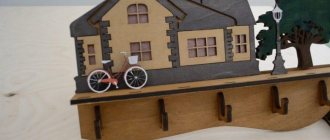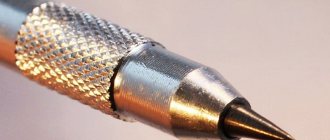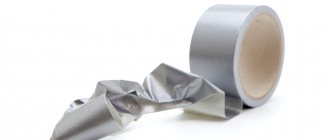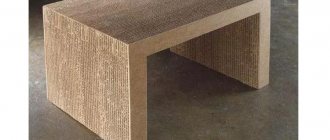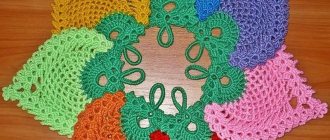Many home craftsmen prefer to make furniture with their own hands. A cabinet or stool assembled in a garage is sometimes in no way inferior in quality to a factory-made product. If the master has the tools and skills, of course.
Moreover, homemade furniture is much cheaper. A sheet of laminated chipboard is relatively inexpensive. With proper sawing, you can make a cabinet and several stools, and maybe more, from one blade. The only question is the size.
But to make furniture, in addition to the above-mentioned skills and tools, you also need special equipment. Various types of conductors and templates for marking, which greatly facilitate the work.
For example, in order to install hinges when assembling cabinet fronts, it is necessary to make the most accurate markings for the strike plates and hinge cups. That's what a template is for. It can, of course, be purchased in a store or online. But in small towns or villages, due to the remoteness, purchasing such devices is very difficult.
Marking for loop
An important part of the correct installation of any furniture hinges is, of course, the most accurate markings. If it is done poorly, it will certainly affect the functionality of the door.
The correct markings for furniture hinges will help you find the right center to make the recesses.
You need to “move away” 7-12 centimeters from the edge. The number of hinges is standard two, but it can vary depending on the type of furniture. It is necessary to maintain a specific distance between the loops. It is equal to fifty centimeters. The door parameters depend specifically on the number of canopies.
When you have finally decided on the quantity and all the necessary dimensions of furniture hinges have been installed, you can mark the central holes in relation to the width of the door. The distance from the side should be approximately two centimeters. It is also impossible not to take into account that the fastening should not be placed where the shelves in the closet or cabinet should be.
After taking all the necessary measurements, make notes. Remembering to respect the width spacing, mark the placement point. At the intersection of these marks, you need to make a “hole” with a nail or a self-tapping screw. If the facade is higher than a meter, make notes every half meter.
For more precise marking, you can use a special template called.
Features of drawing up a drawing
You can make a template yourself if you have a drawing of the future design. To develop a sketch, you need to know what elements the template consists of.
Template structural details:
- Base. There are holes for drilling on it. This part of the furniture hinge installation template is key.
- Holder. The functions of an element include a limitation. The part is fixed to the door leaf, thereby eliminating shifts and deformations.
- Connecting parts. These elements help to adjust the template to specific door hinge sizes. The number of connecting elements depends on the complexity of the structure and the functions assigned to it. The primitive template has only 3 such details.
You can determine the amount of materials needed if you accurately determine the dimensions of the template. The design can be made more complex. You can add the installation of door locks to the functionality of the template.
Adjustment
Adjustment (or adjustment) is the final stage of installation of furniture hinges. It must be performed in several planes at once - vertically, horizontally, and in relation to depth:
- Adjusting the depth will help press the door closer to the body, or ease the pressure. You need to tighten the oval hole.
- On the vertical side - it will help to move the facade. This is done by twisting oval-shaped holes.
- On the horizontal side - ensures free movement of the door back and forth and back. The purpose of this adjustment is to avoid gaps between the cabinet and the door. The method is great for rooms with uneven floors or walls.
Now you know how to secure furniture hinges. As you can see, this is not so difficult to do. You don't need to have any special skills or abilities. Doing this kind of work with your own hands will be another reason for a little pride.
Other types of loops
So, all types of loops can be classified in different ways. Thus, there are different types according to design, purpose, method of fixation and application. In general, there are several dozen types of furniture hinges, some are more common, some are less common, but almost all find application in various types of furniture designs. In addition to four-hinged hinges, let's look at a few more variations of hinges that may be encountered by furniture assemblers or people who have bought new interior items and decided to assemble them themselves.
Card loop
Card loops are considered the oldest. Their ancestor is a forged hinged hinge with a long overlay. Outwardly, they resemble an ordinary door hinge, only slightly smaller in size. The design consists of two metal strips connected in parallel using a thin rod that acts as a hinge. Nowadays they are rarely used, but are indispensable in the manufacture of retro-style furniture.
Butterfly door hinges
Pendulum type hinges or bar hinges make it possible to open the door 180 degrees. What happens is something similar to how the doors open at the entrance to a saloon in old westerns.
Bar loop
Mezzanine hinge structures are designed to attach horizontally oriented doors that will open upward. The hinges have a spring mechanism and also allow you to fix the door when open. They resemble ordinary overhead variations of loops.
Mezzanine hinge MK01
Ombre structures are used for so-called hinged doors. They will be mounted on both ends of the cabinet and do not require insertion, but may require minor milling (up to 2 mm). Then the sash can be opened 180 degrees. This is an ideal hinge for a folding table.
Hinge for folding elements
Secretory structures are similar to the card ones described above; they have an axial hinge and plates. They make it possible to open the façade downwards and keep it in a horizontal position. They can be accompanied by a special bracket that provides a supporting function. Usually installed in those cabinets where a bar is provided.
Secretory loops
Blind hinges, otherwise called adit hinges, are used for doors on the side of the cabinet that is adjacent to the wall. They can be used to attach the door to the false panel.
Gallery hinges
Heel products are extremely rarely used because they are designed only for lightweight doors. But they can be installed on facades with any type of opening. Installation is carried out in the lower and upper parts of the sash.
Heel loops for furniture
There are special hinges for glass sashes. They also come in different types, but their advantage is that they can withstand significant loads, and they look very beautiful.
Glass hinge
And relatively recently, hinges with 8 hinges, eight-hinged, appeared on sale. To install them, you do not need to resort to milling or cutting. This is an improved variation of the usual four-joint hinge. True, they are more difficult to install, and therefore, despite the absence of the need to carry out any preparation, such loops are rarely used.
8-joint hinge
Installation
Having screwed one part of the hinge to the door leaf with self-tapping screws, proceed to inserting the other part into the hinge beam. Different masters carry out this stage in different ways.
- First way . Mark the location of the hinge on the box until it is inserted into the opening. To do this, place it on the floor, place the door leaf inside and, taking into account the upper gap of 3 mm, mark the location of the hinges.
- Second way . When the box is inserted into the opening, the door is placed against it, placing stops underneath. Align to the desired height, taking into account the upper gap, and mark the loops in this position.
- Third way. Although experienced craftsmen do not shift the loops from the originally made marks during the insertion process, they still measure the location of the cards embedded in the canvas just in case.
- The measurement is taken from the top edge of the fabric to the beginning of both loops. For example, the top edge of the top hinge is located 20 cm from the top edge of the door, and the top edge of the bottom hinge is 170 cm from the top edge of the door.
- Then marks are made on the loop beam for the upper edges of the second parts of the loops. In this case, 3 mm is added to the obtained values for the upper gap. In this case, marks are placed at a distance of 20.3 cm and 170.3 cm, respectively.
- Draw arrows indicating in which direction from the mark to embed the loop. Both arrows will point down, as the top edges of the loops are marked.
- Then the second parts of the loops are cut in according to the same pattern.
- This method is convenient when the master works alone and there is no one to help him hold the canvas for method number 2.
Making your own template
Making a template for furniture hinges with your own hands follows a clear plan
It is important to follow the sequence of steps. If you follow all the rules, then there will be no difficulties in the process.
Stages of developing a template for loops:
- Selection and preparation of materials;
- Preparation of necessary tools;
- Development of template details;
- Final assembly of all elements.
Paper template for download
- To create a template yourself, you need to print a sample.
- According to its dimensions, make a blank from solid material, plastic or wood
- Attach the paper template to the workpiece
This is what should happen
To create a workpiece you will need to take a drill, router, hammer, jigsaw. You will also need tools for drawing markings. First you need to make a base. The optimal dimensions are 19x38 cm. A hole measuring 13.5x7 cm should be made in the center. The edges should be smooth. A router will help with this.
Bolts need to be placed on the workpiece
It is important to maintain symmetry relative to the width of the base. The bolts must be deepened into the structure so that they do not interfere with further manipulations
The hole is made wider than the connecting elements and additionally driven in using a hammer.
It is necessary to retreat 7 mm from the 13.5x7 cm holes and make small notches. Around an element with dimensions of 37.5x7 cm, notches are made on one side at a distance of 30 cm from each other.
A homemade template requires a holder measuring 2x5 cm and a length of 5.8 cm. You will need to install a limiter on one of the sides, which looks like a small block. This element will not allow the distance to shift when installing the facade.
Then all parts of the template are attached. Washers are installed under the bolts and nuts. This element increases the durability of the template. The manufacturing process does not require special skills or knowledge. It is enough to familiarize yourself in detail with the template development scheme.
Selection of materials for work
For the template, you can use plywood, chipboard or MDF. More durable structures are made of plexiglass and metal. You can take several materials for one template. So you can use chipboard for the base, and make the guides from a more durable material. It is easier to work with wood, as it is easier to process than glass and metal.
Required connecting elements:
- Bolts. You will need 6 pieces with a thickness of 6 mm and a length of 30 mm. To fix the connecting element, you need to have a 10 key.
- Nuts. Need 6 pieces. The main requirement for the element is convenient adjustment. Wing nuts are most often used.
- Washers. Their diameter should be 6 mm.
- Self-tapping screws. They are selected depending on the thickness of the remaining connecting parts.
What kind of router is needed to install a lock?
The insertion of hinges and locks requires samples of very different sizes. For loops – shallow, according to the thickness of the loop web. Under locks – a large and deep selection. Therefore, professionals who install doors most often use two different routers:
- easy to select for hinges;
- powerful with a large cutter for selecting fits under locks.
When choosing a router for inserting locks, the first thing to determine is its ability to complete the task, that is, to reach the bottom of the planting in depth. The following milling cutters are suitable for this:
- cutter stroke from 70 mm and above;
- shank size (collet fit) 8-12 mm, preferably 12 mm;
- cutter length from 110 to 130 mm.
As a rule, milling cutters with such characteristics in terms of immersion depth have a power of more than 2 kW and a weight of about 6 kg. They easily cope with the task, but they are not very convenient to work with due to their large dimensions and weight. Therefore, other, lighter options are selected with the same depth indicators, which are convenient to choose for locks and hinges.
As an example, BOSCH GOF 1600 CE PROFESSIONAL:
- electric motor power -1600 W (1.6 kW);
- cutter speed - from 10,000 to 25,000 rpm;
- the amplitude of the cutter's stroke up and down is 76 mm;
- replaceable collets for cutters with shanks - 8 mm, 10 mm and 12 mm;
- weight 5.8 kg.
There are models with characteristics suitable in depth with the same or greater power, up to 2.5 kW, and from many other brands.
A more powerful and heavier router is less convenient for such work due to its greater weight and dimensions, but it copes with the task more easily, since when cutting deep niches for locks and latching handles, the router experiences significant loads.
To limit the sampling depth, an adjustment stand with three screws at different heights is used. This function is available on almost all models, so when choosing it it is not highlighted as special or separate.
Description
A furniture jig is a special template tool that is often used by specialists in small and large enterprises to mark drilling points on products and, in some cases, also ensures that the drill fits straight into the material. Depending on the needs of the master, conductors can be either factory-made or self-made. Most often they take the form of a metal template with sleeves for the hole and marking the distance between them. The main advantage of using a furniture jig is that specialists spend less time taking measurements and making markings for drilling.
Using it, you can quickly mark the necessary points on the product blanks, and then make their high-quality connection using different fastening methods. The scope of its application is quite wide, but most often it is used for quick insertion of standard furniture hinges. The device may vary in appearance and markings on the template depending on its intended purpose and operating conditions. For example, a jig for furniture hinges in the production of doors will differ significantly in appearance from a jig that is used to fasten massive furniture doors.
How to install a lock on an interior door
Inserting a lock into an interior door always begins with markings. To prevent the cutter from tearing out the edges of the laminate, the slot location is sometimes covered with masking tape and markings are made on it. Or cut with a sharp knife.
The selection for locking is done in 2 levels:
- a small sample for the overlay strip, to the depth of its thickness.
- deep sampling under the body of the castle itself.
First, the height of the lock is determined. Then a lock is applied from the bottom mark upwards, and marks are made along its cover plate.
The markings for the lock itself are applied after a small sample has been made for the overlay strip. The markings for the lock itself are done like this:
- The center of the door leaf is located in thickness. For example, if the thickness is 37 mm, the center is marked 18.5 mm from the edge.
- The thickness of the lock is measured. If it is 18 mm, 9 mm are marked on both sides from the center of the canvas.
- Several such markings are made, then they are connected by a line of a pencil or marker.
The length marking is made according to the actual size of the lock, it is applied and the markings are made according to the fact.
Instrument setup
The setup is carried out two times:
- For shallow cutting under the lock trim plate, the cutter extends beyond the support platform to the thickness of this strip. For example, 2 mm. A parallel stop is set so that the cutter cannot go beyond the edge of the marking on one side, but follows exactly along the marking. The second marking line when cutting without a template is controlled manually, visually.
- After shallow sampling, the cutter is released to the required depth under the deep sampling, under the lock itself.
An approximate progress of work on such an insert can be seen in the following video.
It is approximate because the marking sequence is different here - all the markings for the overlay plate and the lock body are applied at once. But after selecting a niche for the bar, the markings for the lock itself are removed. Therefore, it is better to adhere to the markup order described above:
- Marking for the bar.
- Sample.
- Marking for the lock itself.
Selecting a lock using not just one parallel stop, but a double-sided adjustable template is shown and understood from the following video:
Drilling holes
Installation is carried out with all the rules:
The depth of the hole for the furniture hinge should be about thirteen millimeters. If possible, the insertion of furniture hinges should not be deeper, otherwise the front side of the canvas may crack; The diameter of the hole depends strictly on the cup of the loop
Tools must be completely aligned with their axis to prevent damage to the surface; A sharpened cutter will help protect the blade from damage and chips; Do not rush while drilling, otherwise there is a risk of doing it sloppily; It is worth paying attention to the dimensions of the cups and their dimensions when installing furniture hinges;
Having drilled one hole, proceed to the next and so on until all the holes for laying the hinges are prepared.
What tools should I use for this?
The bowl must be secured to the facade, and the bar to the body of the bedside table. The furniture hinge must be inserted into the hole, which must be made in advance. The shoulder of the loop becomes a kind of bridge, now connecting both parts. To make holes for such loops, you need to prepare the following tools:
- screwdriver or drill;
- special drill-mill;
The diameter of the cutter for the hole for a furniture hinge is 35 millimeters or 25-26mm. It is selected depending on the size of the loop cups. To create holes for such hinges, you can also use a simple drill.
A multifunctional drill, with attachments that are easy to replace, is quite suitable for such work.
The middle spike must be installed in the center of the circle, outlined using a specially prepared caliber. Automatic calibration is used on the corresponding machines, but at home the master cannot do without a specialized electric tool.
During installation, hinges require a high level of care and precision. The chance to complete exactly the required niche is the most important advantage of the so-called Forstner drill. It can provide a stop that will prevent you from penetrating further than required. And the teeth of the drill do not allow it to deviate from the intended “course”. The end result is an almost perfect hole. And due to this, the cup fits into the recess quite tightly.
But the above-mentioned drill also has one significant drawback, which manifests itself when working with a solid piece of wood. This is low quality, which is to be expected if the instrument was not made in a factory. This is why you should choose tools exclusively from official companies. And, of course, don’t forget about warranty cards.
Depending on the type of panel you are working with, the cutter can get quite hot. Due to this, it can burn the edges and wood that is removed from the recess. That is why, when working with such a foundation, you should not forget about breaks in work. So that the drills have time to cool down at least a little. Working in three to four sets will be ideal.
Particular attention should be paid to breaks when working with MDF sheets. If the activity is carried out with chipboard sheets, parts made of strong alloys will be able to make recesses for hinges really quickly and without much stress
Which cutters to use
To insert a lock into an interior door, groove end mills with a cutting edge on the sides and end are used.
There is a specialization - cutters designed specifically for this operation. They meet the requirements for the depth and width of the cut, the cutters are made of hard alloys (type VK8), which equally well select grooves in wood of any hardness, MDF, plastic and composite materials, and cut through laminate well.
These cutters are available in different sizes. Average values:
- height of cutting knives 30 mm;
- diameter of the working part of the cutter is 12 mm;
- total length of cutter 120 mm;
- shanks in three options - 8 mm, 10 mm and 12 mm.
When the cutter stroke on a router is 70 mm, such a cutter can select a groove for a lock with a depth of about 90 mm.
Large cutters are also available:
- working part diameter 16 mm;
- total length 130 mm.
Their cost fluctuates around 1500 rubles, plus/minus 300-500 rubles. But there are copies costing only 150-500 rubles. and over 3000 rub.
The leaves of many modern doors made of MDF, blocks (not solid wood) may have a small thickness of the side bar into which the lock cuts. For example, 50 mm, beyond which the void begins. For such doors it is not necessary to use long cutters with a large cutting depth.
Fastening rules
Most often, no preparation is needed to connect parts made of wood using self-tapping screws - the screws can be screwed into the part without drilling a hole. For these purposes, use a Phillips screwdriver or screwdriver. You need to act smoothly and carefully, especially when working with oxidized screws (they are considered the most brittle).
The tool should be kept strictly in line with the screwing hardware. You should not try to screw the fastener into the knot - despite the fact that these are the densest areas, such fastening will be considered ineffective. If you plan to screw screws into high-density natural wood, it is recommended to pre-lubricate the hardware with laundry soap. It will act as a lubricant and ensure easier insertion of the fastener into the material.
It is worth considering that the screw should not go through the 2 structures being connected.
Before drilling, you need to apply markings, and then make a hole in the main part measuring 0.8 times the diameter of the screw. The depth of the hole must correspond to the screw-in base of the hardware. If the fasteners are thin, you can use an awl.
When drilling soft lumber, it is also possible to make holes by hand. To work with hard materials, drill a hole that matches the profile of the screw-in fastener. To make a recess you need a drill and a drill. It is best to use a countersink.
After the preparatory work, the screw is inserted into the hole. It must be strengthened in the material by twisting it clockwise with a screwdriver. In this case, the correct selection of hand tools is important. If you take a screwdriver that does not match the size, there is a high risk of damaging the slot on the head - in this case, it will be impossible to tighten the fastener. You can also fasten screws using electric or pneumatic screwdrivers. Their use makes work easier and speeds up the assembly process.
The final stage is installing stickers or plugs on the fastener heads. Such accessories are sold in a wide range of colors. Their main task is to camouflage fasteners. Thanks to the use of stickers, you can increase the aesthetics of finished furniture.
For more information on screws and self-tapping screws, see below.


